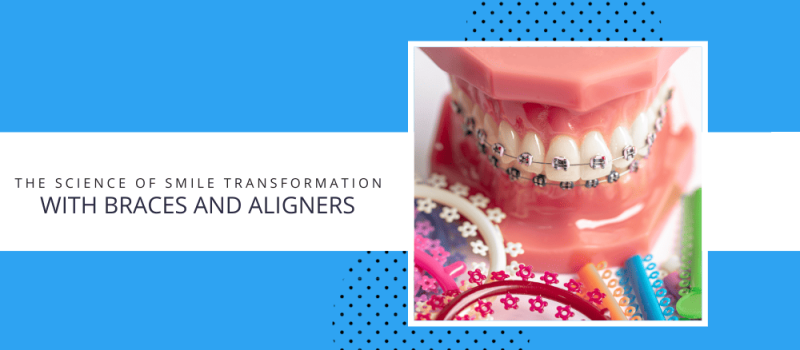
Orthodontics has long been known as the branch of dentistry that specializes in correcting the alignment of teeth and jaws. At Sullivan Orthodontics, we are dedicated to helping patients achieve their most radiant and healthy smiles through state-of-the-art orthodontic treatments and personalized care. It’s essential to understand how orthodontic treatment works to appreciate the incredible potential of braces and aligners like Invisalign to transform your smile.
Orthodontic treatment relies on the scientific principles of biomechanics, which involve applying gentle, consistent pressure on teeth to shift them to their ideal position. Both braces and clear aligners like Invisalign employ these principles to correct dental malocclusions, such as overbites, underbites, crowding, and spacing. Additionally, orthodontics plays a vital role in improving oral health and function by making teeth easier to clean, thereby reducing the risk of gum disease and tooth decay and promoting proper bite alignment.
In this informative article, we will delve into the science behind orthodontics in Bend, examining the mechanics of braces and clear aligners like Invisalign, their applications for various orthodontic issues, and the treatment timeline for achieving lasting results. By understanding the scientific foundation of orthodontics, you can better appreciate the value of personalized, comprehensive orthodontic treatment to achieve a healthy, beautiful smile.
The Mechanics of Braces: Moving Teeth with Precision
Traditional braces are a time-tested orthodontic solution for addressing various dental misalignments. Comprised of brackets, archwires, and elastic bands, braces use gentle, controlled force to shift teeth into their ideal positions gradually. Here, we will detail the mechanics of braces and how they facilitate tooth movement:
- Brackets: Brackets are bonded to the front surface of the teeth and act as anchors for the archwires. They can be made from metal, ceramic, or even clear materials for a more discreet appearance.
- Archwires: The archwires are the primary force behind tooth movement. Made of metal, these wires are threaded through the brackets and apply gentle pressure to the teeth in the desired direction of movement.
- Elastic Bands: Elastics or rubber bands are used to connect the brackets and apply additional force to guide the teeth and jaws into alignment. The bands can be customized in various colors, making them a fun design element for children and teens.
Invisalign: A Clear Alternative for Aligning Teeth
For those seeking a more discreet orthodontic option, Invisalign clear aligners offer an innovative solution to traditional braces. Invisalign aligners are custom-made, virtually invisible trays that fit snugly over the teeth and gradually shift them into proper alignment. Let’s explore the science behind Invisalign treatment:
- Customized Design: Invisalign uses advanced 3D imaging technology to create a personalized treatment plan, mapping the precise movements your teeth will make throughout the process.
- Series of Clear Aligners: A series of custom-made, clear plastic aligners are fabricated based on your unique treatment plan. Each aligner is designed to apply consistent force on specific teeth, in a controlled manner, to facilitate their movement.
- Progressive Treatment: Patients typically wear each set of aligners for one to two weeks before moving on to the next set in the series. As you progress through the aligners, your teeth will gradually shift into their desired positions.
Treatment Duration: The Timeline for a Stunning Smile Transformation
Orthodontic treatment timelines can vary depending on several factors, such as the severity of the dental issues being addressed, the type of orthodontic solution used, and individual patient compliance. Here, we will discuss the general treatment duration for braces and Invisalign:
- Braces: The average treatment time with traditional braces ranges from 18 months to three years. Several factors can impact this timeline, including the patient’s age, the complexity of the orthodontic issues, and the desired outcome of the treatment.
- Invisalign: Invisalign treatment typically requires a shorter treatment time compared to braces, with most cases being completed within 12 to 18 months. However, treatment time may vary depending on the complexity of your case and your commitment to wearing the aligners for the recommended 20-22 hours per day.
Maintaining Oral Hygiene During Orthodontic Treatment
To ensure successful treatment outcomes and maintain the health of your teeth and gums, it’s vital to practice proper oral hygiene throughout your orthodontic journey:
- Brushing: Brush your teeth at least twice a day, preferably after each meal, to remove food debris and plaque buildup around your braces or aligners.
- Flossing: With braces, use a floss threader and waxed floss to clean between the teeth and under the wires. For Invisalign wearers, simply remove your aligners and floss as normal.
- Regular Dental Visits: Continue to visit your general dentist for regular cleanings and check-ups during your orthodontic treatment. Your dentist will monitor your oral health, address any issues, and advise on any additional cleaning or maintenance practices.
Experience the Science of Smile Transformation with Sullivan Orthodontics
Understanding the scientific principles behind orthodontic treatment can help you fully appreciate the power of braces and Invisalign to create beautiful, healthy smiles. With a personalized and comprehensive approach to treatment, Sullivan Orthodontics can help you achieve your dream smile.
If you’re interested in learning more about the science of orthodontics and the treatment options available at our Bend office, schedule a consultation with us today. Our experienced team is dedicated to providing exceptional orthodontic care tailored to your unique needs, utilizing the latest advances in orthodontic technology and treatment strategies.
